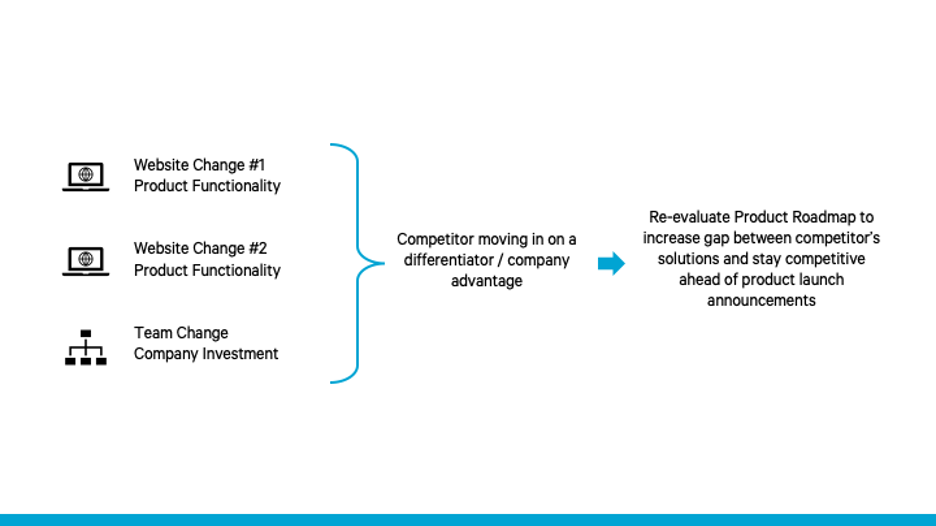Competitive Intelligence (CI) is growing. According to the recent State of Competitive Intelligence Report, more than half (57%) of businesses have CI teams of two or more dedicated CI professionals, compared to just 37% of businesses two years ago. In the same study, respondents cited measuring CI impact on the organization as one of the top challenges. CI, when done well, has wide-reaching impact across the organization. But just because a company has invested in CI headcount, it does not necessarily mean that the organization has built an Intelligence Culture. Building a culture of competitive intelligence in your company can open the doors to greater (measurable, visible) impact across every department.
What is an Intelligence Culture?
An Intelligence Culture is when everyone at an organization routinely makes decisions and takes action based on competitive and market intelligence. The ideal Intelligence Culture is when every employee in an organization sees the act of gathering, analyzing, and distributing competitive intelligence as a shared responsibility and essential to doing their jobs well.
Get your free copy of the Guide to Competitive Intelligence >>
Why build an Intelligence Culture?
Competitive intelligence strongly contributes to bottom-line impact when implemented and executed correctly. While there are many positive business outcomes from CI, the three key areas in which it contributes is revenue, ability to quickly shift and adapt to market changes, and the ability to drive impact across every part of the organization.
How Competitive Intelligence Impacts Revenue
Competitive intelligence is a key contributor to revenue. The State of Competitive Intelligence found that companies that share CI daily or weekly were twice as likely to see revenue increases as a result of CI compared to those who shared less frequently or not at all.
Sharing CI effectively to the degree it impacts revenue goes beyond sending an email newsletter or a periodic update. It requires building an organizational-wide framework around gathering and disseminating CI. Building that framework is the foundation you need to build an Intelligence Culture.
How Competitive Intelligence Enables You to Pivot and Adapt to Competitor & Market Shifts
CI isn’t simply collecting information and taking it at face value. It requires you to connect seemingly disparate pieces of information and synthesize them to understand where your competitor is headed in terms of strategy.
Let’s take a look at Fuze, the cloud communications company, as an example of an organization that excels at CI. Fuze noticed a couple of small changes to their competitor’s website product pages. While it at first didn’t seem like much, shortly after, there was a major executive team change in their competitor’s product organization. They were able to put the pieces together to figure out that their competitor was moving in on one of their key differentiators. So what did they do? They gathered key stakeholders and decided to adjust their product roadmap so that they could maintain their competitive advantage and preempt their competitor’s launch.

How Competitive Intelligence Drives Impact Across the Organization
Competitive intelligence, when done well, positively impacts every part of your organization. This is what impact looks like at an organization with a healthy Intelligence Culture:
- Sales: Distill CI via dynamic battlecards and alerts to achieve higher win rates and more revenue
- Marketing: Differentiate marketing messaging and campaigns to drive pipeline for sales and see higher marketing performance
- Product: Contribute to decision making on the product roadmap as well as surface opportunities for product to add/shift roadmap priorities
- Executive Team: Brief the executive team on major market shifts that will help inform their decision making when building strategy
There are many other ways in which CI drives impact across these teams, but these are just a few examples of what’s possible.
The Three Building Blocks of an Intelligence Culture
An Intelligence Culture isn’t built overnight; It takes the commitment to build an organization-wide CI framework and invest in the headcount and tools necessary to execute on said framework. Let’s take a look at the three key building blocks for creating an Intelligence Culture in your organization:
- Create a Competitive Intelligence Framework
- Align Competitive Intelligence with Core Business Initiatives
- Make CI Everyone’s Responsibility
Building Block #1: Create the CI Framework
Creating a CI framework is no easy task, but it’s essential if you want to build an Intelligence Culture. There are many details and nuances that go into creating a CI framework, but let’s talk about the two that are most impactful when it comes to creating and supporting an Intelligence Culture.
Centralizing Competitive Intelligence
If you want everyone in your organization to participate in CI, then there needs to be a single place where all intelligence is gathered, stored, and discussed. Having a single source of truth for CI combats conflicting and/or outdated information making the rounds, as well as duplication of efforts.
Creating a centralized CI space doesn’t mean that there is a single CI “gatekeeper.” In fact, it’s quite the opposite—organizations with a strong intel culture are constantly interacting with competitive data in real-time, so it’s essential that everyone in an organization has self-serve access that allows them to do so.
Self-serve access enables everyone in the organization to leverage CI for their specific needs, as well as comment and discuss insights with their team members.
For example, demand generation teams should be able to see relevant CI, such as competitor campaigns, landing pages, etc. Product teams should be able to see changes to website product pages, third-party product reviews, etc. Giving self-serve access to everyone in your organization allows everyone to get involved and make intelligence-based decisions for their teams.
Standardize CI Distribution Methods
While centralizing CI in one place is key, you need to distill intelligence into different formats and channels based on the team. Here are a few examples of distribution channels for CI.
- Alerts: Whether by email or Slack/chat, alerts are a great way to notify colleagues who need to know about any major competitive or market movements.
- Email Digests: Weekly roll-ups on competitor movements are a great way to keep everyone in the know at scale.
- Sales Battlecards: The only thing worse than no battlecard is an inaccurate battlecard. Getting crucial intelligence to sales via dynamic battlecards is key to impacting competitive win rates.
- Competitor Analyses: Deep-dive analyses of new potential markets, how a competitor addresses a certain use case, or strengths and weaknesses of the competitive set allow you to uncover larger scale trends and prepare for expansion into markets and products.
- Executive Boards: Execs want the high-level, need-to-know information. Whether it’s a major market change/disruption (i.e., COVID-19) or a longer-term analysis of a competitor’s strategy, showing executives a visual and information-rich board will help you brief them on everything they need to know.
Building Block #2: Align with Core Business Initiatives
As mentioned earlier, CI teams often struggle to measure the impact of their efforts. And one of the major causes of that is that they often don’t align their KPIs with core business initiatives.
The State of Competitive Intelligence found that 50% of CI teams set KPIs, so while that is a positive step for CI as a whole, teams must ensure that those KPIs align with the core goals of the business. When setting KPIs for your CI team, ensure that every single KPI is directly tied to a core business goal. This will help you assess whether or not you are making an impact on the organization, and it will help everyone else see and therefore believe in the impact CI can have on the bottom-line—a crucial piece to building a healthy Intelligence Culture.
Building Block #3: Make CI Everyone’s Responsibility
It takes a village when it comes to building an Intelligence Culture. You can’t wake up and decide one day that you will single-handedly implement all of the things that make up an Intelligence Culture. You need people, and those people need to buy into your vision. If everyone sees CI as a critical function AND feels as though it’s their responsibility to contribute to that function, then you will have a flourishing Intelligence Culture.
Educate Internal Teams
Most of your colleagues who are not on the CI team have a vague idea of what is actually involved in CI and even less so the powerful impact it can have on an organization. Taking the time to conduct internal training on what CI is, how it helps certain teams, and how they can get involved will go a long way in putting CI top of mind and get you on the road to building an Intelligence Culture. Consider making it an internal roadshow—go around to each team and show how CI can help them and how they can leverage it for their own purposes.
Consult in Every Team’s Processes & Initiatives
It might seem overly obvious to say that as a CI person you should be the go-to for all things CI. However, CI teams are often used to pushing out information to teams, rather than teams coming to them for information (think push vs. pull).
When teams kick off a new initiative, they should be seeking out intelligence as part of their decision-making process. For example, when the Product team is exploring a new feature for the roadmap, they should be coming to the CI team to gather intelligence on which features competitors have been releasing, how they are positioning those features, what the customer feedback has been, etc.
If there’s one thing that signals a healthy Intelligence Culture, it’s an organization that integrates CI into their decision making across all teams.
Give Visibility to Teams that Leverage CI
Much of the battle of building an Intelligence Culture is gaining visibility around CI and the success it yields. Calling attention to when teams leverage CI will help normalize the use of CI across the organization and encourage other teams to use CI in their day-to-day.
Here are some situations where you can give shout-outs to teams who leverage CI:
- When a sales rep submits intel from the field
- When product launches a feature that is intended to be a big competitive differentiator
- When marketing runs a competitive campaign or retools their messaging
Shouting out when these teams leverage CI will go a long way in helping you build a healthy and lasting Intelligence Culture.
Building An Intelligence Culture Takes Time. Start Now.
There’s a lot of information to absorb here, so let’s summarize the why and the how of building an Intelligence Culture.
Why build an Intelligence Culture?
Competitive intelligence directly impacts business outcomes for organizations, chief among them being revenue, the ability to anticipate and adapt to market shifts, and the ability to impact all parts of the organization.
No Intelligence Culture means CI is a nice-to-have at best and a cost center at worst.
How do I start building an Intelligence Culture?
Admittedly this can be a big undertaking that is chock-full of nuances, and it will require a lot of planning on your part. Here is a high-level overview of the steps you need to take:
- Create a CI framework for your organization. Invest in resources and tools that will help you centralize all CI and engage everyone with the intelligence directly.
- Align with core business goals. Set KPIs and ensure that every single one of them ties back to a key business goal.
- Make CI everyone’s responsibility. You might be the CI pro, but it’s everyone’s job to leverage intelligence to make decisions. Educate teams and be a helpful, key player in their decision making processes.
Good luck!

Seeing is believing! Check out Crayon for yourself.
Take a Product TourRelated Blog Posts
Popular Posts
-
 The 8 Free Market Research Tools and Resources You Need to Know
The 8 Free Market Research Tools and Resources You Need to Know
-
 6 Competitive Advantage Examples From the Real World
6 Competitive Advantage Examples From the Real World
-
 How to Create a Competitive Matrix (Step-by-Step Guide With Examples + Free Templates)
How to Create a Competitive Matrix (Step-by-Step Guide With Examples + Free Templates)
-
 24 Questions to Consider for Your Next SWOT Analysis
24 Questions to Consider for Your Next SWOT Analysis
-
 How to Measure Product Launch Success: 12 KPIs You Should Be Tracking
How to Measure Product Launch Success: 12 KPIs You Should Be Tracking

